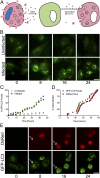Nonlytic viral spread enhanced by autophagy components
- PMID: 25157142
- PMCID: PMC4246951
- DOI: 10.1073/pnas.1401437111
Nonlytic viral spread enhanced by autophagy components
Abstract
The cell-to-cell spread of cytoplasmic constituents such as nonenveloped viruses and aggregated proteins is usually thought to require cell lysis. However, mechanisms of unconventional secretion have been described that bypass the secretory pathway for the extracellular delivery of cytoplasmic molecules. Components of the autophagy pathway, an intracellular recycling process, have been shown to play a role in the unconventional secretion of cytoplasmic signaling proteins. Poliovirus is a lytic virus, although a few examples of apparently nonlytic spread have been documented. Real demonstration of nonlytic spread for poliovirus or any other cytoplasmic constituent thought to exit cells via unconventional secretion requires demonstration that a small amount of cell lysis in the cellular population is not responsible for the release of cytosolic material. Here, we use quantitative time-lapse microscopy to show the spread of infectious cytoplasmic material between cells in the absence of lysis. siRNA-mediated depletion of autophagy protein LC3 reduced nonlytic intercellular viral transfer. Conversely, pharmacological stimulation of the autophagy pathway caused more rapid viral spread in tissue culture and greater pathogenicity in mice. Thus, the unconventional secretion of infectious material in the absence of cell lysis is enabled by components of the autophagy pathway. It is likely that other nonenveloped viruses also use this pathway for nonlytic intercellular spread to affect pathogenesis in infected hosts.
Keywords: live imaging; virus spread.
Conflict of interest statement
The authors declare no conflict of interest.
Figures




References
-
- Lloyd RE, Bovee M. Persistent infection of human erythroblastoid cells by poliovirus. Virology. 1993;194(1):200–209. - PubMed
-
- Pelletier I, Duncan G, Colbère-Garapin F. One amino acid change on the capsid surface of poliovirus sabin 1 allows the establishment of persistent infections in HEp-2c cell cultures. Virology. 1998;241(1):1–13. - PubMed
Publication types
MeSH terms
Substances
Grants and funding
LinkOut - more resources
Full Text Sources
Other Literature Sources

